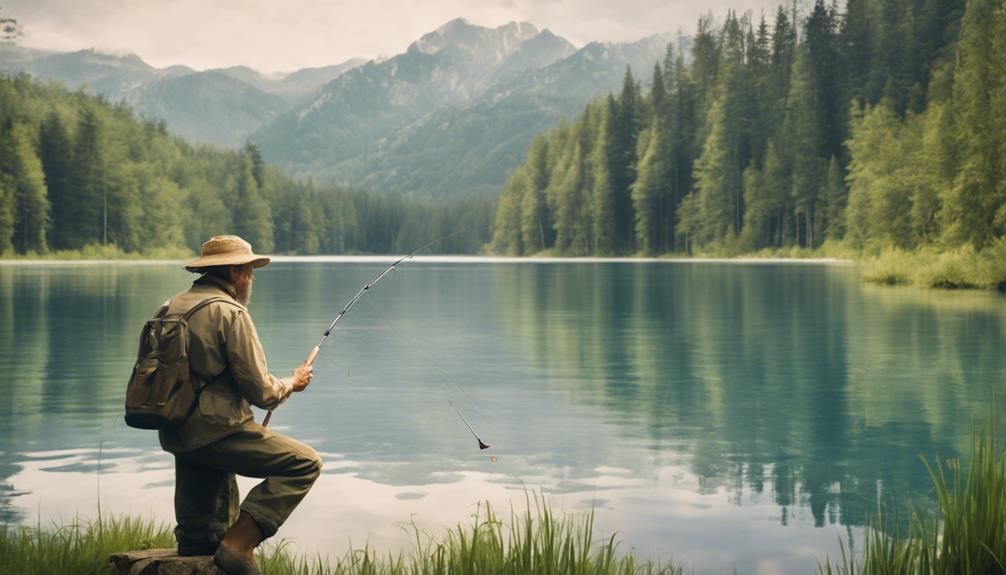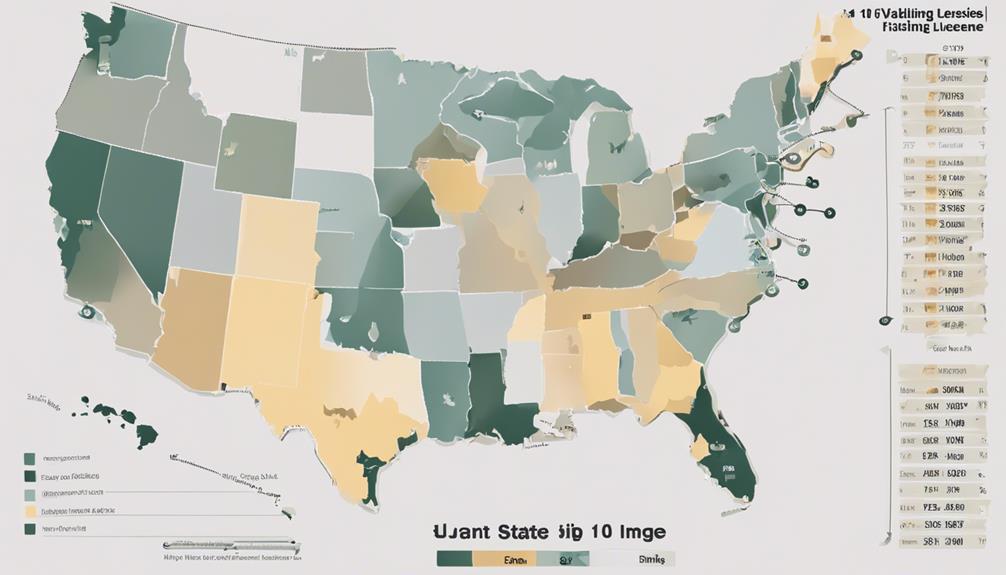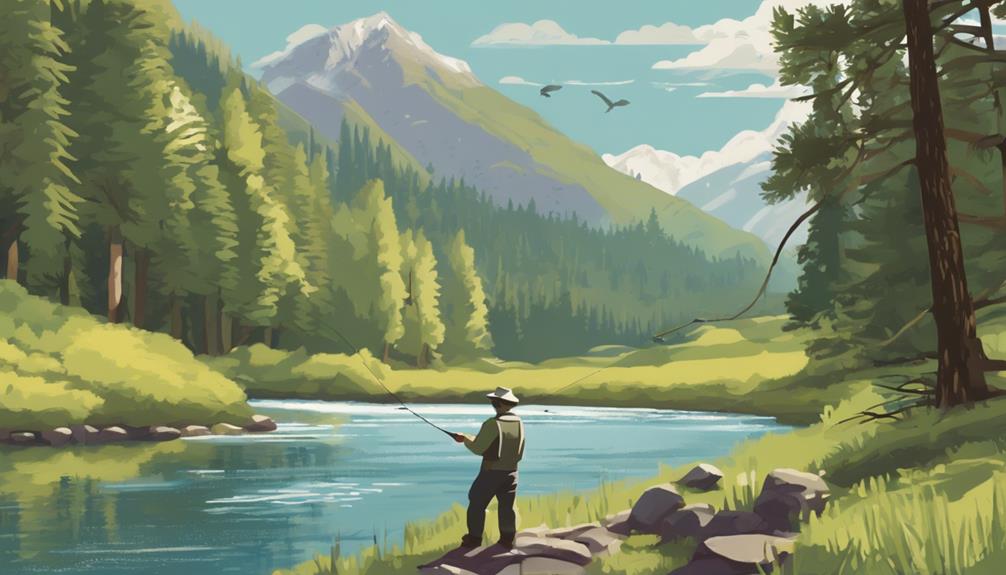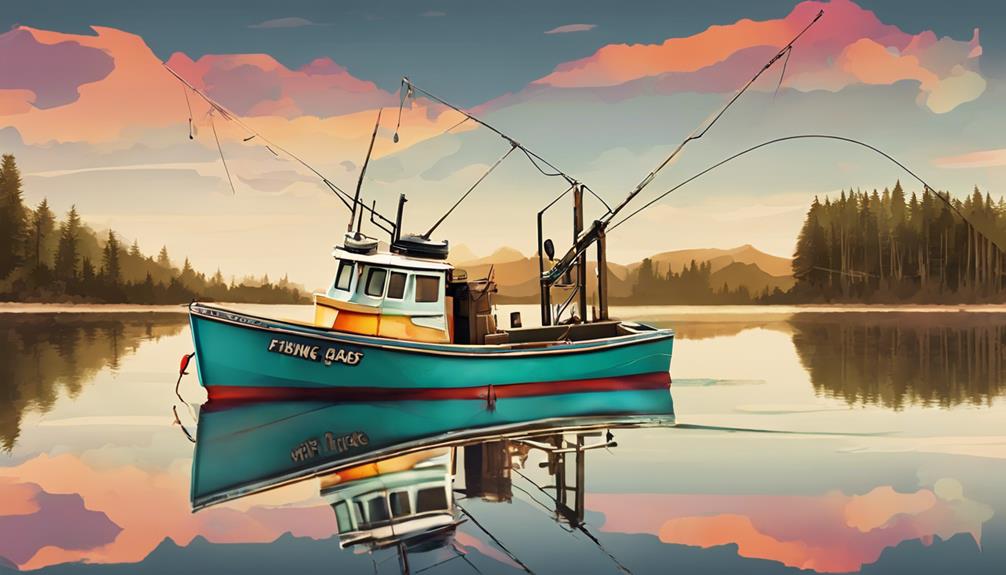When it comes to fishing in protected areas, you've probably heard the saying, 'With great power comes great responsibility.' Understanding the top 10 fishing regulations in these designated zones can make a significant difference in preserving the ecosystem.
From types of permits required to penalties for violations, each rule plays a crucial role in maintaining the delicate balance of nature. Discover how these regulations aim to safeguard marine life and habitats while ensuring sustainable fishing practices.
Types of Fishing Permits
To legally fish in protected areas, you must obtain specific types of fishing permits. Understanding the fishing license requirements and costs is crucial before embarking on your fishing trip. In protected areas, different regulations apply to recreational and commercial fishing, each requiring distinct permits.
Recreational fishing permits are typically easier to obtain and less costly compared to commercial fishing permits. These permits are designed for individuals or groups engaging in fishing for leisure or personal consumption. The fees for recreational fishing permits are generally lower since the impact on the environment is minimal compared to commercial operations.
On the other hand, commercial fishing permits are more stringent in terms of requirements and cost. These permits are necessary for individuals or companies looking to fish on a larger scale for profit. Due to the potential environmental impact and the need for sustainable practices, commercial fishing permits often come with higher fees and stricter regulations.
Understanding the distinction between recreational and commercial fishing restrictions is vital to ensure compliance with the regulations in protected areas. By obtaining the appropriate fishing permits based on your fishing intentions, you contribute to the preservation of marine ecosystems while enjoying the fishing opportunities these areas offer.
Catch Limits and Size Restrictions
Understanding the catch limits and size restrictions is crucial when fishing in protected areas to ensure compliance with regulations and promote sustainable fishing practices. By adhering to these regulations, you contribute to the conservation efforts aimed at maintaining the delicate balance of marine ecosystems.
Here are some key points to keep in mind regarding catch limits and size restrictions:
- Catch Limits: These limits specify the maximum amount of fish that can be caught per person per day. Exceeding these limits can put a strain on fish populations and hinder sustainability practices.
- Size Restrictions: Size restrictions dictate the minimum and/or maximum size of fish that can be kept. Allowing fish to reach maturity ensures the continuity of species and supports conservation efforts.
- Selective Harvesting: Selective harvesting involves targeting specific species while avoiding others to maintain biodiversity and ecosystem health. This practice aligns with sustainability practices and helps prevent overfishing.
- Release Techniques: Learning proper catch-and-release techniques is essential for returning undersized or excess fish back to the water unharmed. This approach minimizes the impact on fish populations and supports long-term conservation efforts.
Gear Restrictions in Protected Areas
Gear restrictions in protected areas aim to regulate the types of equipment and methods allowed for fishing activities within designated conservation zones. These restrictions are put in place to ensure sustainable practices and habitat preservation. By limiting the gear that can be used, authorities can protect sensitive ecosystems and prevent overfishing in these critical areas.
Common gear restrictions in protected areas include bans on destructive fishing gear such as bottom trawling nets that can cause significant damage to the seabed and marine life. Instead, sustainable gear like handlines, fishing poles, and traps are often permitted as they have less impact on the environment. These restrictions not only help in conserving fish populations but also contribute to maintaining the overall health of the marine ecosystem.
Furthermore, regulations may specify the type of bait that can be used to reduce harm to non-target species. By promoting selective fishing practices, these restrictions support habitat preservation by minimizing bycatch and protecting the balance of the ecosystem. Additionally, limits on the number of hooks or lines a fisherman can use help prevent excessive harvesting and ensure that fishing activities remain within sustainable levels.
Closed Seasons for Fishing Activities
In protected areas, fishing activities are regulated through closed seasons to manage and protect fish populations effectively. By implementing specific time periods where fishing is prohibited, authorities can ensure fishing sustainability and conservation efforts are maximized, minimizing the impact on ecosystems and biodiversity.
Here are four key reasons why closed seasons for fishing activities are crucial in protected areas:
- Fish Reproduction: Closed seasons align with fish breeding periods, allowing fish populations to reproduce without disturbance. This helps in maintaining healthy population levels and genetic diversity within the ecosystem.
- Ecosystem Recovery: Pausing fishing activities during critical times allows ecosystems to recover from human impact. It gives marine life a chance to replenish, contributing to overall biodiversity and ecosystem health.
- Preventing Overfishing: Closed seasons prevent overfishing by setting limits on when fishing can occur. This control helps in avoiding the depletion of fish stocks and ensures sustainable fishing practices for the future.
- Balanced Fisheries Management: Implementing closed seasons is part of a comprehensive fisheries management strategy. It aids in balancing the needs of the fishing industry with long-term conservation goals, promoting a harmonious coexistence between human activities and marine environments.
Special Fishing Zones and Restrictions
To further enhance the effectiveness of fishing regulations in protected areas, it's crucial to establish designated special fishing zones and restrictions. Marine sanctuaries are particularly important areas where specific regulations can help protect vulnerable marine species and habitats. By designating certain areas within these sanctuaries as special fishing zones, authorities can control the fishing activities to ensure sustainable fishing practices. These zones can also serve as areas for conservation efforts to thrive without the threat of overfishing or habitat destruction.
In these special fishing zones, restrictions can be put in place to limit the type of fishing gear used, the species that can be targeted, and the quantity of fish that can be caught. This level of control is essential for maintaining the delicate balance within marine ecosystems. Recreational fishing, while a popular activity, can also have detrimental effects if not properly regulated. Therefore, establishing special fishing zones within marine sanctuaries can help mitigate these impacts and safeguard the biodiversity present in these areas.
Environmental Protection Measures
When considering environmental protection measures in fishing regulations for protected areas, it's essential to prioritize the preservation of marine ecosystems. Sustainable practices are crucial to ensure the long-term health of these ecosystems and the species that rely on them.
Here are four key environmental protection measures to incorporate into fishing regulations for protected areas:
- Implementing Catch Limits: Setting catch limits helps prevent overfishing, allowing fish populations to replenish and maintain a healthy balance within the ecosystem.
- Establishing No-Take Zones: Creating designated areas where fishing is prohibited helps protect vulnerable species and critical habitats from exploitation.
- Promoting Selective Fishing Gear: Encouraging the use of selective fishing gear reduces bycatch and minimizes the impact on non-target species and the marine environment.
- Enforcing Seasonal Closures: Implementing seasonal closures during sensitive times such as breeding or spawning seasons helps protect the reproductive success of marine species and contributes to the overall sustainability of the ecosystem.
Enforcement of Fishing Regulations
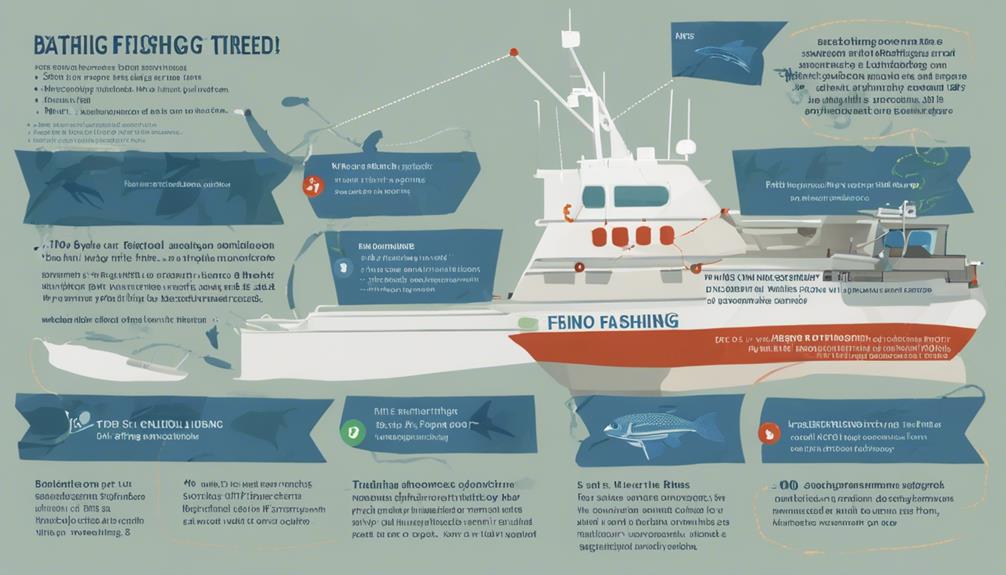
Enforcing fishing regulations within protected areas ensures compliance with conservation measures and safeguards the integrity of marine ecosystems. However, enforcement faces various challenges, such as limited resources, vast areas to cover, and the clandestine nature of illegal fishing activities. To address these challenges, effective compliance strategies are essential.
One key enforcement challenge is the difficulty in monitoring and patrolling vast marine protected areas. Limited manpower and resources can make it challenging to detect and deter illegal fishing activities effectively. To overcome this, employing technology such as drones, satellite surveillance, and underwater cameras can enhance monitoring capabilities and improve enforcement efforts.
Another enforcement challenge is the lack of coordination among different agencies responsible for enforcing fishing regulations. Establishing clear protocols and enhancing communication between agencies can streamline enforcement processes and ensure a more coordinated response to violations.
Compliance strategies play a crucial role in promoting adherence to fishing regulations. Educating the fishing community about the importance of conservation, sustainable fishing practices, and the consequences of non-compliance can help foster a culture of respect for regulations. Additionally, implementing community-based enforcement programs where local stakeholders are involved in monitoring and reporting violations can enhance compliance and deter illegal fishing activities effectively. By addressing enforcement challenges and implementing robust compliance strategies, protected areas can better preserve marine ecosystems for future generations.
Penalties for Violating Regulations
Penalties for violating fishing regulations within protected areas serve as critical deterrents against illegal activities, ensuring accountability and upholding conservation efforts. When these regulations aren't adhered to, fines and other consequences are imposed to discourage further violations.
Here are some of the penalties you may face if you violate fishing regulations in protected areas:
- Fines: Monetary fines are commonly imposed on individuals caught violating fishing regulations. These fines can vary in amount depending on the severity of the violation and are meant to deter future illegal fishing activities.
- Confiscation of Equipment: In addition to fines, authorities may confiscate fishing equipment such as nets, lines, or traps used in the illegal activity. This not only acts as a penalty but also prevents further harm to the environment.
- Suspension of Fishing Privileges: Violating fishing regulations may result in the temporary suspension of fishing privileges within the protected area. This serves as a consequence for the violation and highlights the seriousness of adhering to conservation guidelines.
- Legal Action: In certain cases of severe or repeated violations, legal action may be taken against the offender. This can lead to court appearances, criminal records, and more severe penalties as determined by the law. It's crucial to understand and respect fishing regulations to avoid facing these consequences.
Frequently Asked Questions
Are There Any Designated Areas Within the Protected Areas Where Catch-And-Release Fishing Is Allowed?
In designated areas within protected zones, catch-and-release fishing is often allowed. This practice supports fishing ethics and conservation efforts by minimizing harm to fish populations. It also helps maintain healthy ecosystems by reducing the impact on species protection.
When engaging in catch-and-release fishing, be mindful of guidelines to ensure the well-being of the fish and the environment. Always respect fishing regulations and strive to contribute positively to the conservation of marine life.
Can Anglers Use Live Bait in the Protected Areas or Are There Specific Restrictions on Bait Types?
You can use live bait in some protected areas, but there are specific restrictions to consider. These regulations are put in place to help with conservation efforts and protect the ecosystem.
Before you head out for a day of fishing, make sure to check the rules regarding bait types in the area you plan to fish. Adhering to these guidelines ensures that you can enjoy your angling while also contributing to the preservation of the environment.
Are There Any Specific Regulations Regarding the Use of Drones or Other Technology for Fishing in Protected Areas?
When fishing in protected areas, specific regulations govern drone use and technology for conservation. Drones can disrupt wildlife, so restrictions are in place. Using technology responsibly helps protect the environment.
Be mindful of the impact on nature and follow guidelines to preserve these special areas. Remember, conservation practices are crucial for the sustainability of these protected areas.
Respect nature and enjoy your fishing experience while minimizing your environmental footprint.
Are There Any Restrictions on the Use of Underwater Cameras or Other Fishing Gadgets in the Protected Areas?
When exploring protected areas, it's important to consider fishing etiquette and conservation efforts. Using underwater cameras or fishing gadgets can disrupt wildlife interaction and have negative environmental impacts. Be mindful of how your actions may affect the delicate balance of these ecosystems.
Remember that respecting the regulations in place is key to preserving the beauty and sustainability of these protected areas.
Are There Any Specific Guidelines for Anglers Who Want to Fish From a Boat or Kayak Within the Protected Areas?
When boat fishing or kayak fishing in protected areas, make sure to follow safety guidelines. Always wear a life jacket and carry necessary safety equipment. Check local regulations for specific requirements.
Respect marine life and the environment by avoiding sensitive habitats. Be mindful of other water users and keep noise levels low.
Enjoy your fishing experience while preserving the beauty of the protected areas.
Conclusion
Overall, it's important to follow the top 10 fishing regulations in protected areas to ensure the sustainability of our marine ecosystems. By obtaining the necessary permits, adhering to catch limits and size restrictions, and respecting closed seasons and special fishing zones, we can help protect the environment and preserve fish populations for future generations.
Remember, enforcement of these regulations is crucial, and penalties may be imposed for those who don't comply. Let's all do our part to fish responsibly and protect our precious natural resources.
